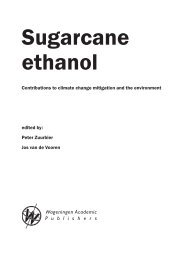Production and use of fuel ethanol in Brazil - BAFF
Production and use of fuel ethanol in Brazil - BAFF
Production and use of fuel ethanol in Brazil - BAFF
Create successful ePaper yourself
Turn your PDF publications into a flip-book with our unique Google optimized e-Paper software.
C2.3.<br />
How does the remuneration for work <strong>in</strong> the<br />
<strong>in</strong>dustry compare to other analogous <strong>in</strong>dustries <strong>in</strong><br />
the nation?<br />
The differences <strong>in</strong> regional development reflect <strong>in</strong> the <strong>in</strong>dustry’s <strong>in</strong>dicators; poorer<br />
regions are characterized by lower salaries <strong>and</strong> a more labor-<strong>in</strong>tensive activity, as<br />
a function <strong>of</strong> the technological level <strong>in</strong> place (automation, mechanization). In the<br />
agricultural area, the mean education level <strong>in</strong> the North-Northeast region is half as<br />
much (<strong>in</strong> terms <strong>of</strong> years spent at school) as <strong>in</strong> the Center-South.<br />
Consider<strong>in</strong>g both formal <strong>and</strong> <strong>in</strong>formal jobs (2005 PNAD sample), the <strong>in</strong>come <strong>of</strong><br />
engaged <strong>in</strong>dividuals <strong>in</strong> <strong>Brazil</strong> was:<br />
For all sectors:<br />
R$ 801/month; R$462 <strong>in</strong> agriculture; R$ 770 <strong>in</strong> the <strong>in</strong>dustrial sector; <strong>and</strong><br />
R$ 821 <strong>in</strong> the service sector.<br />
Sugar-cane, agricultural area:<br />
<strong>Brazil</strong>, 495; N-NE, 316; C-S, 697; São Paulo, 810.<br />
Industry, <strong>ethanol</strong>:<br />
<strong>Brazil</strong>, 960; N-NE, 600; C-S, 985; São Paulo, 1,196.<br />
The amounts for those engaged on the <strong>in</strong>dustrial side <strong>of</strong> sugar production are a little<br />
lower (around 20 percent) than those for <strong>ethanol</strong> production.<br />
In the Center-South region, people engaged <strong>in</strong> sugar-cane grow<strong>in</strong>g have a higher<br />
<strong>in</strong>come than those engaged <strong>in</strong> c<strong>of</strong>fee <strong>and</strong> corn grow<strong>in</strong>g, equivalent <strong>in</strong>come to that<br />
<strong>of</strong> citrus fruit growers, but a lower <strong>in</strong>come than that <strong>of</strong> people engaged <strong>in</strong> soybean<br />
grow<strong>in</strong>g (which is highly mechanized <strong>and</strong> <strong>in</strong>volves more specialized jobs). In the<br />
North-Northeast region, the <strong>in</strong>come from sugar-cane grow<strong>in</strong>g is higher than <strong>in</strong><br />
c<strong>of</strong>fee, rice, banana, cassava <strong>and</strong> corn crops, also equivalent to the <strong>in</strong>come from<br />
citrus fruit grow<strong>in</strong>g, <strong>and</strong> lower than that earned <strong>in</strong> soybean grow<strong>in</strong>g.<br />
The <strong>in</strong>come <strong>in</strong> formal jobs does not <strong>in</strong>clude the 13 th salary (m<strong>and</strong>atory annual bonus<br />
equivalent to one month’s salary) or any benefit.<br />
C. Sugar-cane <strong>and</strong> <strong>ethanol</strong> production: social impacts<br />
61












